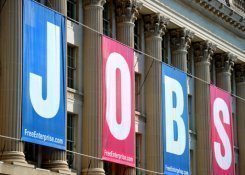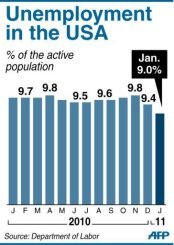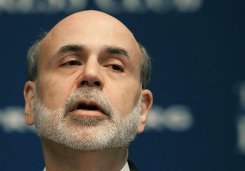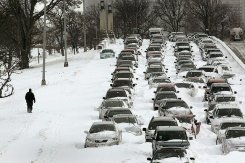January snowstorms cloud US jobs market
 |
| US unemployment rate has fallen to a 22-month low of 9.0 per cent |
 |
| Unemployment rates in the USA from January 2010 to January 2011 |
 |
| Federal Reserve Chairman Ben Bernanke |
 |
| Cars sit in the northbound lanes of Lake Shore Drive |
The struggling economy added a meager 36,000 jobs, the Labor Department said, an increase that was much smaller than the 148,000 expected.
But bad weather along with statistical adjustments clouded the data, offering a contradictory snapshot of the still-weak jobs market.
A separate survey showed a sharp 0.4 percentage point drop in the unemployment rate, which fell to a 22-month low of 9.0 per cent.
Economists said that was at least partly because hundreds of thousands of people disappeared from the statistics thanks to an annual population revision. But according to Nigel Gault of IHS Global Insight, Friday's news is positive, if a little opaque.
"The payroll details and the drop in unemployment signal that there is an underlying improvement in the labor market buried under the snow and ice," he said.
The decline in the jobless rate "reflected more people finding jobs, not more people giving up and leaving the labor force," he said.
The 9.0 per cent jobless rate was the lowest since April 2009, when it stood at 8.9 per cent; it had been above 9.0 per cent ever since.
But as job creation remained far below the 200,000-a-month level which experts say is needed to get employment back to where it was before the recession, the White House sounded a cautious tone.
President Barack Obama's administration said unemployment was still painfully high as it vowed to put the government-supported recovery on a sustainable track.
"The 0.8 percentage point decline in the unemployment rate over the past two months is a welcome development; however, the rate remains unacceptably high," White House chief economist Austan Goolsbee said in an official blog.
"The overall trend of economic data in recent months has been encouraging, as initiatives put in place by this administration are taking hold, but there is still considerable work to do."
Since a low in February 2010, employment has increased by an average of 93,000 a month, leaving policymakers hesitant to let the economy stand on its own.
Federal Reserve chairman Ben Bernanke warned Wednesday the economy was still in "a deep hole" more than a year and a half after the Great Recession ended.
"Until we see a sustained period of stronger job creation, we cannot consider the recovery to be truly established," the central bank chief said at a rare news conference.
Details of Friday's data appeared to show the jobs market was heading in the right direction, but at the wrong velocity.
The private sector added 50,000 jobs, offsetting the loss of 14,000 payrolls in the federal and state governments.
Jobs were added in manufacturing, a key engine of the recovery from recession, up 49,000, and in retail trade. Sectors typically affected by inclement weather such as construction shed 32,000 jobs.
Most other major industries saw little change in employment over the month, the Labor Department said.
The economy has added only about one million jobs compared with the nearly 8.7 million lost between December 2007 and February 2010, according to official data.
"Aside from today’s muddled picture, one thing is crystal clear: the US labor market started 2011 with half a million fewer jobs than it had 11 years ago in January 2000," said Heidi Shierholz of the Economic Policy Institute.
Shierholz said that if just half the pool of 4.9 million "missing workers," workers who dropped out of or did not enter the labor force during the downturn, were currently in the workforce and counted among the unemployed, the jobless rate would be 10.5 per cent instead of 9.0 per cent.
"None of these workers is reflected in the official unemployment count, but their eventual entry or re-entry into the labor force will contribute to keeping the unemployment rate high going forward."
What the stars mean:
★ Poor ★ ★ Promising ★★★ Good ★★★★ Very good ★★★★★ Exceptional
 Tag:
Tag:
Related Contents
Latest News
More News
- 72 nations sign landmark Hanoi cybercrime convention (October 26, 2025 | 18:00)
- UN Secretary-General commends Vietnam’s global leadership (October 26, 2025 | 09:00)
- APEC finance ministers convene to tackle regional challenges (October 22, 2025 | 17:31)
- Rewiring global trade: ASEAN’s rise as supply chain hub (October 17, 2025 | 11:40)
- Vietnam attends first World Nuclear Week Forum in Russia (September 26, 2025 | 10:50)
- Vietnam attends 69th session of IAEA General Conference (September 16, 2025 | 10:00)
- ADB, WB pledge over 12 billion USD for ASEAN power grid, renewable energy projects (August 15, 2025 | 14:18)
- Lowy Institute proposes AI-based tobacco control solutions for ASEAN (August 15, 2025 | 14:14)
- Cloud computing policy to position Malaysia as regional hub by 2030 (August 15, 2025 | 14:11)
- Thailand, Cambodia suffer numerous cyber attacks (August 05, 2025 | 16:19)
























 Mobile Version
Mobile Version